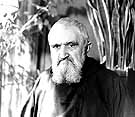
|
|
|

|

|

|

|
|
Click on an image to see a larger, more detailed picture.
|
|
|
|
|
| 1944: Desperate Acts |

|
pg. 513 |

|
|
|
|
| |
 Nahum Goldmann helped create the World Jewish Congress (WJC) in 1936. The organization, headquartered in the United States, sought "to assure the survival and to foster the unity of the Jewish people." The Holocaust only deepened Goldmann's conviction that a Jewish state must be established in Palestine.
Nahum Goldmann helped create the World Jewish Congress (WJC) in 1936. The organization, headquartered in the United States, sought "to assure the survival and to foster the unity of the Jewish people." The Holocaust only deepened Goldmann's conviction that a Jewish state must be established in Palestine.
Photo: American Jewish Archives/United States Holocaust Memorial Museum Photo Archive
|
 Unlike many of the Nazis' victims who had no hope of freedom, members of the Jehovah's Witnesses needed only to sign an Erklärung (declaration) to be released from Dachau or other concentration camps. Although the Nazis sought to separate the Witnesses from one another and break their spirit, most remained steadfast, unwilling to pledge their loyalty to Hitler. Jehovah's Witnesses saw the persecution as a sign of the approaching final judgment.
Unlike many of the Nazis' victims who had no hope of freedom, members of the Jehovah's Witnesses needed only to sign an Erklärung (declaration) to be released from Dachau or other concentration camps. Although the Nazis sought to separate the Witnesses from one another and break their spirit, most remained steadfast, unwilling to pledge their loyalty to Hitler. Jehovah's Witnesses saw the persecution as a sign of the approaching final judgment.
Photo: KZ Gedenkstätte Dachau/United States Holocaust Memorial Museum Photo Archive
|
 Pierre Marie Benoît
Pierre Marie Benoît
While many churchmen chose silence and safety during the Holocaust, an heroic few remembered the admonition to love one's neighbor, whether Jew or Christian. A Capuchin monk of the Franciscan order, Father Pierre Marie Benoît rescued Jews first within his native France and later in Rome. From the safety of his Marseilles, France, monastery, Father Benoît witnessed the roundups of non-French Jews destined for concentration camps. Like Protestant Pastor André Trocmé, Benoît believed that effective action was possible. His monastery became a center of rescue activity for Jews seeking to escape to neutral Switzerland or Spain. Following the Nazi occupation of Vichy France, Benoît prepared a bold rescue effort in concert with French and Italian authorities to save the 30,000 Jews living in Nice and send them to safety in North Africa. This plan was thwarted by the Nazi occupation of northern Italy. Such obstacles spurred Benoît to initiate new rescue efforts, focusing on the Jews of Rome. Working with Jewish organizations and using a false name, Benoît saved over 100 Jews by supplying them with counterfeit identity papers and by persuading various embassies to help in his endeavor. Following the war, Benoît was named "Righteous Among the Nations" by the Yad Vashem.
Photo: Yad Vashem / United States Holocaust Memorial Museum Photo Archive
|
|

|

|

|

|
 February 24, 1944: Anticipating escapes, the SS deports 200 Sonderkommando prisoners from Auschwitz to the death camp at Majdanek, Poland, where all 200 are shot.
February 24, 1944: Anticipating escapes, the SS deports 200 Sonderkommando prisoners from Auschwitz to the death camp at Majdanek, Poland, where all 200 are shot.
|
 March 1944: German forces invade and occupy Hungary. The kitchen-utensil factory of industrialist Oskar Schindler is nearby, and Schindler repeatedly intercedes with local authorities to prevent the arrests and deportations of his Jewish employees; See Summer 1944.
March 1944: German forces invade and occupy Hungary. The kitchen-utensil factory of industrialist Oskar Schindler is nearby, and Schindler repeatedly intercedes with local authorities to prevent the arrests and deportations of his Jewish employees; See Summer 1944.
|
 March 1944: Three hundred Jewish orphans from the Transnistria region of Romania are given safe passage to Palestine.
March 1944: Three hundred Jewish orphans from the Transnistria region of Romania are given safe passage to Palestine.
|
 March 1944: Jews on the island of Rab, off the coast of Dalmatia, Serbia, are arrested and deported to Auschwitz.
March 1944: Jews on the island of Rab, off the coast of Dalmatia, Serbia, are arrested and deported to Auschwitz.
|
 March 1944: Germans begin to evacuate Jewish concentration-camp inmates to the west as the Soviets advance from the east. The Reich orders the destruction of camp documents and corpses.
March 1944: Germans begin to evacuate Jewish concentration-camp inmates to the west as the Soviets advance from the east. The Reich orders the destruction of camp documents and corpses.
|
|
|
|
|
| 1944: Desperate Acts |

|
pg. 513 |

|
|
The Holocaust Chronicle
© 2009 Publications International, Ltd.
|
|
